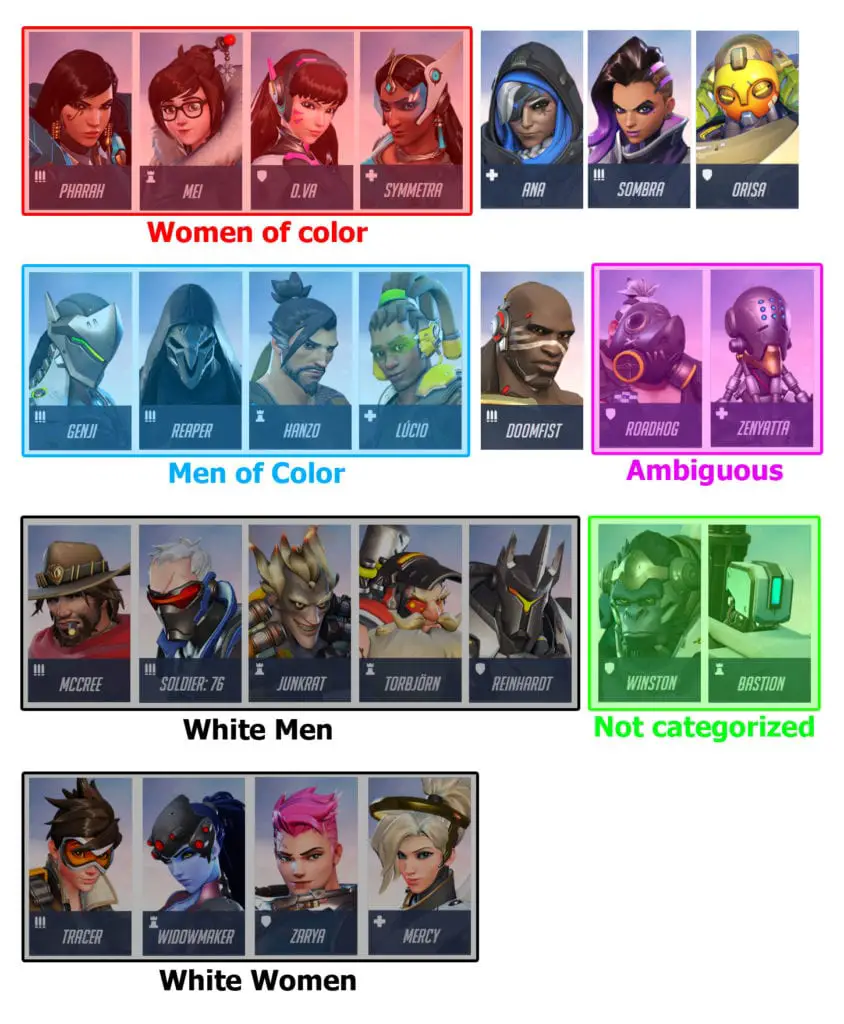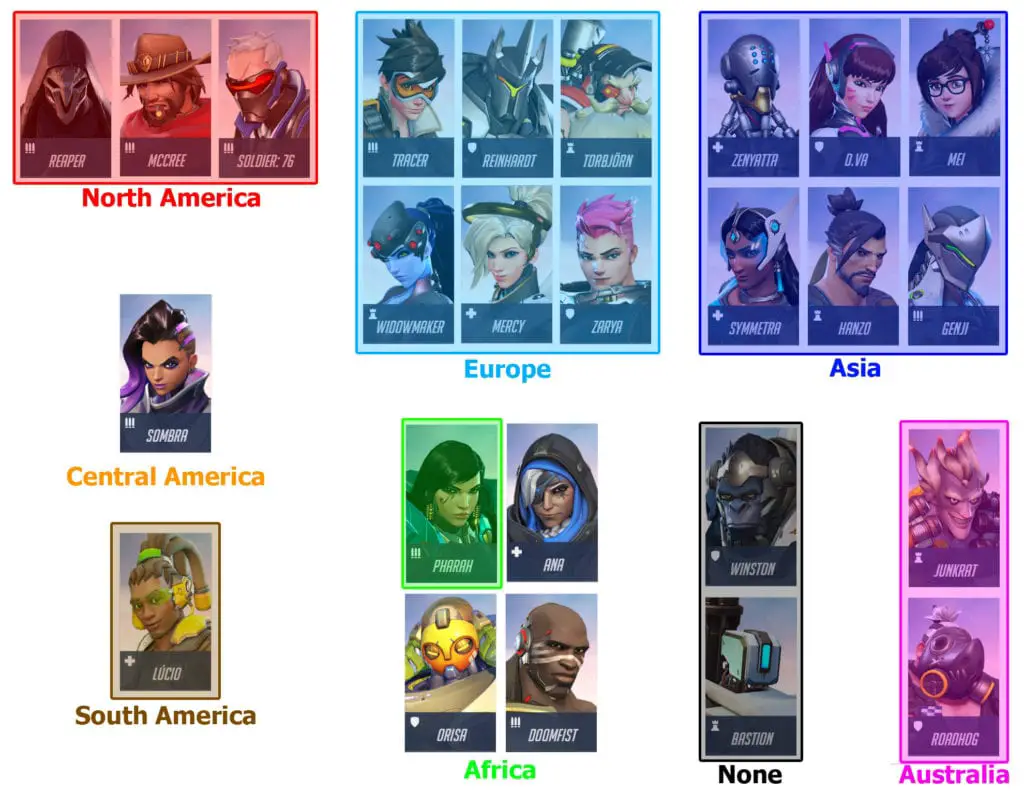Overwatch director Jeff Kaplan once stated that the creative team “cared about creating a game… where everybody felt welcome.” This article will cover diversity within the game and how it changed from launch to present, using the metric of which heroes’ design elements fall prey to or avoid harmful stereotypes of the groups they represent. The 4 new heroes are compared to the original 21 to see whether designs have improved or fallen short in relation to fans’ most commonly voiced concerns. Overwatch has attracted a very diverse fanbase, so I reference opinions and analysis from those who are being represented by the character in question as much as possible.
This is Part 1, covering gender, race, nationality, and ethnicity.
Gender
The most recognizable aspect of diversity within this game is gender. While I view gender as a complex and multidimensional spectrum, games from big publishers still typically present it as binary, with exceptions made only for non-human entities. Overwatch definitely falls into this category.
At launch, 38% of the available heroes were female, 57% were male, and one was genderless. Two of them, Zenyatta and Bastion, are omnics (sentient robots). I counted Zenyatta as male but not Bastion due to the pronouns used in the official Overwatch bios, as well as this tweet by lead writer Michael Chu. Bastion, as noted in the tweet, is genderless. While the acknowledgement is nice and keeps the line-up from being completely binary, it would be better to see non-binary heroes who are human. A female to male ratio of 2:3 is better than many FPS games out there, but hardly groundbreaking.
The new heroes help even the numbers. Ana, Sombra, and Orisa are all female, and Doomfist is the only male. That makes the current lineup 44% female, 52% male, and 1 genderless. That’s almost half and half (11 vs 13). While I personally don’t find a difference of one or two heroes significant with a lineup as big as Overwatch’s, I do think the diversity within each gender falls a little short. Age and body type, for example, are much more limited among female characters than male characters.
Even face shapes are pretty similar, but I’ll cover this in more detail in Part 2.

Race
Notably, all four of the new heroes are people of color, so racial diversity is clearly a conscious choice for the Overwatch team. While racial lines can sometimes be tricky with real people, in Overwatch it’s more straightforward with a couple of exceptions.
The lineup at launch included 8 clear examples of people of color: 4 women and 4 men, with 2 ambiguous cases, Roadhog and Zenyatta. The main criterion I used here was consistency of cues in each hero’s design elements. I counted Reaper as a man of color, because his design elements point to it and do not contradict each other. His Origins skin depicts him before his transformation, and he has obviously dark skin. His voice actor for the U.S. version appears to be a man of color as well. Although Zenyatta’s voice actor is also a man of color, I did not count him because, as an omnic, he does not have a skin color. Furthermore, his alternate skin designs borrow from several different cultures instead of one consistent one.
Similarly, I did not count Roadhog. Though there is a strong case for him being a man of color—the mixing of different cultural cues, reliance on stereotypical depictions, and appearance of darker skin in one of his skins complicates things. I’ll discuss culturally conscious depictions in more detail in the “Ethnicity” section.

The current lineup of heroes features 7 women of color and 5 men of color, for a total of 12 people of color out of 25 heroes. That’s nearly half the available heroes. “Race”, from a global perspective is pretty fuzzy, so it’s hard to say if it’s representative of world demographics. If nothing else, it’s a nice change of pace from “grizzly white guy #5765”, particularly when it comes to FPS games. Better yet, none of the new heroes fall into the ambiguous category the way Zenyatta or Roadhog do.
My one concern is that the balance is skewed toward women of color over men of color at the moment. A difference of two isn’t huge, but hopefully it’s something the development team will keep in mind as they continue introducing characters. Alternatively, if they clarify the backgrounds of Zenyatta and Roadhog, it will be perfectly even, but I don’t expect them to.
Nationality
Overwatch is set on a future version of Earth and specifically elicits a global theme in its maps, heroes, and backstory for the Overwatch coalition itself. Therefore, geographical distribution should be a priority for the development team.
At launch, 3 heroes were from North America, 6 from Europe, 6 from Asia, 2 from Australia, 1 from Africa, and 1 from South America. The starting lineup was heavily weighted toward North America, Europe, and Asia. These three regions comprised 71% of all heroes. Only one hero each from Africa and South America seems woefully inadequate considering those are entire continents composed of countless diverse countries.
Central America had no representation at all at launch. This is even worse when race is taken into account. Of the 10 heroes from the U.S., Europe, and Australia, Reaper was the only person of color (and possibly Roadhog as discussed previously). This is disappointing because representation like this perpetuates the idea that these regions are composed solely of white people, which simply isn’t true. When I was teaching in rural Japan, most students imagined “Americans” exclusively as blond-haired, blue-eyed, gun-toting people.
East Asia was also over-represented, with 4 out of the 6 heroes from Asia hailing from the east and being fair-skinned. As much as I love seeing East Asian representation, there is so much more to Asia than Korea, China, and Japan. There are darker-skinned people, especially in Southeast Asia, for example. In general, Blizzard’s decisions of which heroes hail from which countries reinforces assumptions about what people in each country look like.

The new heroes do nothing to dispel this, since they are all people of color from nations where they are the majority. They do, however, add some geographical diversity with Ana from Egypt, Orisa from a fictional city in West Africa, Doomfist from Nigeria, and Sombra from Mexico. This brings the tally up to at least one hero for every continent excluding Antarctica. Antarctica is woven into the story as the Ecopoint: Antarctica map, where Mei conducted climatology research.
The coverage for Africa has certainly improved, but it’d be great to see some heroes whose race and nationality break some stereotypes. For instance, South America would benefit from more heroes that reflect the many nations and ethnicities that exist there. That said, it would take careful planning on Blizzard’s part to maintain or improve the balance of racial and national diversity while doing so. For example, some Argentinians are ethnically Chinese, but East Asian ethnicities are already over represented. Any hero of color from the US or a European nation would contribute further to the disproportionately high number of heroes from those areas. It’s certainly a delicate balance.
Ethnicity
First, some context. In general, most of Blizzard’s early character designs in Overwatch are cartoony, exaggerated caricatures. This is true across all heroes and seems intentional as part of the goofy and larger-than-life appeal of the game.
McCree is a walking cowboy stereotype. Hanzo is a dragon-powered, bow-wielding assassin in the midst of Overwatch’s futuristic weaponry. Zenyatta is a vaguely Asian, mystical guru with fortune cookie voicelines. However, Reinhardt, Torbjorn, and Widowmaker are all just as comically stereotypical of U.S. views of people from their respective countries. It’s one thing to depict a marginalized group in a way that reinforces stereotypes, leading to fetishization or othering (or both), and quite another when the group is widely accepted and depicted diversely in media. There are plenty of articles that discuss these issues in greater detail, such as this, this strongly worded one with good details about racial stereotypes, and this excellent post by tumblr user Tabine about Symmetra specifically.
Blizzard seems to have taken note of criticisms here, with newer heroes being much more nuanced while still fitting the fun and cartoony atmosphere of the game.
Ana, for example, gets to be a tough and capable leader, while also being nurturing and protective. Criticisms of Pharah included her lack of Arabic lines; Blizzard found someone who could voice Egyptian Arabic lines for Ana. She is not only a mother but also a soldier, and as far as I know, does not fall into any troubling stereotypes related to her background. Sombra likewise, is undeniably Mexican and a hacking genius, who hasn’t stirred any serious controversies.
On the omnic side of things, Orisa is a dramatic improvement over Zenyatta. It’s clear what her origins are despite her fictional location, and Efi smashes at least a couple of stereotypes as a genius robotics inventor who happens to be a young black girl. Check out this article for more about why Orisa is awesome. Doomfist is new enough that there aren’t many articles out about him as a character as opposed to just his mechanics, but the initial impression seems to be positive. The original lineup isn’t without its successes, however. D.Va has apparently become a feminist icon in her home country.
Conclusion
The size of Overwatch‘s hero list gives Blizzard room to design characters that represent many different experiences around the world. Mistakes have definitely been made in trying to make those designs “welcoming” the way that the team hoped, but progress has been made too. The design choices for newer characters reflect an awareness of fans’ criticisms and a greater effort to research the cultural backgrounds used.
There’s still plenty of room for growth, but Blizzard has shown it’s willing to learn.

